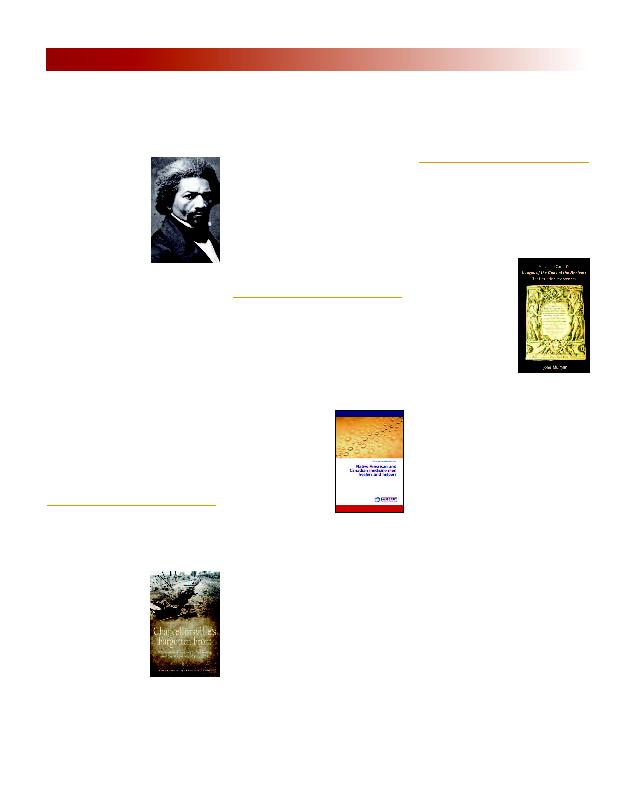
Main Man Films of Englewood, Colo., for
his award-winning screenplay about the in-
spirational life of 19th-century civil rights pi-
oneer Frederick Douglass.
Gleason said he will re-
tain the role as
writer/producer.
glass," the script earned
Best Screenplay honors
at the Buffalo Niagara
Film Festival in 2009. The
award was bestowed just a few blocks from
where Douglass is believed to have crossed
into Canada in 1859 while fleeing in exile
for his connection to John Brown and the
Harper's Ferry uprising.
self-educated fugitive slave who rises from
the bondage of slavery in Maryland to inter-
national acclaim as America's greatest civil
rights leader of the 19th century, coura-
geously and brashly changing history as an
orator, author, abolitionist and statesman.
He's also written a romantic comedy, two
novels, a supernatural horror tale, a techno-
thriller and numerous humor essays. Learn
more at www.kerrygleason.com/nsfd.
tion, has co-authored three new Civil War
books. Two of the books, "A Season of
Slaughter: The Battle of
Spotsylvania Court
House" and "The Last
Days of Stonewall Jack-
son," are part of the
Emerging Civil War Se-
ries. They follow Mack-
owski's first book in the
series, "Simply Murder:
The Battle of Fredericks-
burg," released last De-
cember.
ten Front: The Battles of Second
Fredericksburg and Salem Church."
White, are available from publisher Savas
Beatie LLC.
of the Civil War's most important battles
and stories, with a focus on storytelling.
"The Civil War is America's great story,"
Mackowski adds, "and it's full of smaller
stories that are compelling and relevant,
even after 150 years."
of two battles that took place as part of the
Chancellorsville campaign in May of 1863.
founders of the blog Emerging Civil War.
has published a book about the techniques
used by Native American and Canadian
medicine men.
healers in her ongoing pursuit of investigat-
ing the influence of tra-
ditional healers on
family and community.
The result is "Native
American and Canadian
medicine men, healers
and helpers," published
by Lambert Academic
Publishing. The book is
available at
https://www.more-
books.de (search for healers and helpers).
Yorùbá traditional healers and later, as an
adult, researched the interpersonal tech-
niques they used.
their own ethnic group and without," said
Adekson, who spent three days observing,
interviewing and audiotaping native medi-
cine men, healers counselors and helpers in
a clinic on the St. Regis Mohawk Reserva-
tion.
and audiotaped nearly a dozen traditional
healers, counselors and helpers from the
Mohawk Tribe of Akwesasne, the Cayuga
Tribe of Canada, the Seneca Tribe of Catta-
Onondaga Tribe of Canada, the Oneida
Tribe of Canada, the Oneida Tribe of Wis-
consin, the Mescalero Apache Tribe of New
Mexico, and the Lakota Sioux of North
Dakota.
never knowing in the tedium of such metic-
ulous work whether anyone would care to
publish the culmination of his labor. Ulti-
mately, his painstaking efforts were re-
warded, first with the
1,024-page English
translation of Natale
Conti's "Mythologiae"
in 2006, the most im-
portant mythography
published during the
Renaissance; and again
last year with the publi-
cation of the 485-page
translation of Vincenzo
Cartari's "Images of
the Gods of the Ancients," the first
mythography written in Italian.
ages of the Gods of the Ancients," a cop-
per-plate book worth 30 times as much
today. But the real price Mulryan paid was
the untold hours spent translating Cartari's
work.
the summary of a myth and then tells you
what it means," Mulryan said -- to be
written in Italian. "By writing this in Ital-
ian, he made the mythological tradition
available to women for the very first time
because women were not educated in
Latin."
fusely illustrated with captioned images of
the pagan gods, and composed in the Ital-
ian vernacular.
sance Studies, includes 23 images scanned
directly from his 405-year-old copper-plate
book. Mulryan's book is the first complete
English translation of Cartari's Italian text,
and the only annotated translation of the
"Images" in any language. He retired in
2011 after 45 years as an English professor
at St. Bonaventure.